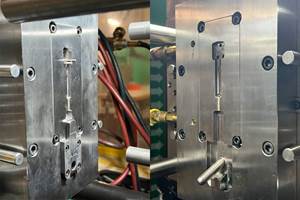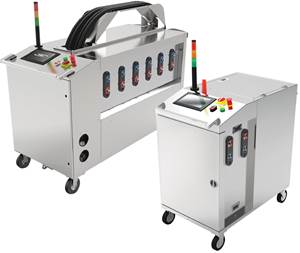Why Mold-Maintenance Data Is Essential for Processing Technicians
When I was in the Navy, many different trades such as hydraulics, electrical, airframes, armament, and jet-engine mechanics worked side by side to get planes into the air, through their scheduled missions, returned to base, and turned around to do it all over again.
When I was in the Navy, many different trades such as hydraulics, electrical, airframes, armament, and jet-engine mechanics worked side by side to get planes into the air, through their scheduled missions, returned to base, and turned around to do it all over again. All departments interacted while doing their own tasks to keep a squadron of a dozen jet fighters “mission ready.”
Getting a jet into the air at a moment’s notice might be considered a more critical priority than getting a mold started and running good parts—or not, depending upon your point of view. The lesson for me was in seeing how standardized data formats allowed essential information to be collected and utilized by all departments. It had to be this way to prevent the chaos that could occur if every department worked in isolation from each other, taking a “that’s-not-my-job” approach.
This military maintenance methodology also works in plastics manufacturing. Although all departments in a plant contribute something to manufacturing and selling plastic products, there are a few that deal directly with the front-line concerns of molding products.
Making it all work right depends on getting the front-liners the types of mold performance and maintenance information they need, and for them to know how to use it effectively. The right data in the right hands at the right time is the most powerful tool in your box.
START WITH ‘PAR’
Let’s begin our analysis at the obvious starting point—a production-ready mold (blue- or green-tagged) set in the press, watered up, and ready to go. There are many processing questions a mold start-up technician will consider before the first parts come off the mold. Having access to documentation and checklists for start-up direction makes this task much easier.
Many companies provide their processing technicians with a Work Order packet that gives some process and production instructions for a particular part number to be run. This information is normally production-related—not about performance or repair. But once problems start to occur, more in-depth knowledge of the mold’s characteristics during performance and repair (PAR) will be required to quickly troubleshoot and resolve the problems.
PAR-type information won’t be found in your typical work-order packet. It will be found within the gray matter of a technician who has experience with common performance issues of this mold, running this configuration, in this press, with this resin, etc. In other words, whatever can be remembered about this specific set-up. In world class shops, PAR data will be accurate, electronic, and available in several departments.
If the start-up technician does not have quick and easy access to PAR data, then troubleshooting will become a “tweak-and-see” exercise and valuable time will be wasted. In attempting to solve a part-quality issue, technicians will try various process adjustments to get production going. These workarounds often hide root causes—such as mold issues—that could be corrected or eliminated when a mold is on the bench, thus making the processes more robust with less fiddling required from start to part.
To acquire this advantage, data continuity must first be established between the tool room and the processing floor (at the press) to share valuable information that both departments can use to eliminate guesswork and wasted time and money trying to remember what was done in the past, who did it, and how.
Here is a sample of PAR data that process technicians should be aware of before they start setting up a mold:
- Configuration changes or changeovers: Different tooling installed in a mold base to run a different part number can greatly influence process parameters and mold characteristics.
- New tooling installed: From a Q/A standpoint, areas of parts formed by new tooling need to be measured and qualified before product can be released. New tooling can also have an effect on the process.
- Cavities shut off: Cavities that the tool room cannot repair, and thus remain blocked, need to be brought to the attention of the molding technician in case shot-size or other adjustments need to be made before the mold is started up.
- Hot-runner manifold maintenance: Not knowing that a manifold is empty can cause serious problems. Freshly cleaned or purged hot-runner manifolds must be filled slowly to ensure that critical seals are not blown open from high pressures.
MOLD MAINTENANCE ISSUES
Mold maintenance can induce several issues that a process technician might see at start-up and would want to verify quickly to avoid wasting time looking for processing workarounds. It is not necessary for a start-up technician to know upfront every detail about a typical mold PM or clean-and-repair—but he/she must have quick access to this data in case issues should arise. And just as repair technicians like to know how many cycles a mold ran before they begin repairing it, a processor likes to know generally what was done to a mold before starting it up—especially if the mold is a problem child.
Any of the issues noted below could be related to maintenance performed or not performed. It should be noted that the common theme in troubleshooting any mold-related processing issue depends upon your ability to answer the first three questions on the Troubleshooting Flow Chart below.
- Water, oil, or air leaks: Does the mold have a history of leaking and if so, where? Was the mold worked on recently, and were any o-rings changed or disturbed? Did the mold receive a thorough final check before being sent to production? If it didn’t leak on the bench, then it could be clamp or injection-pressure related (cracked tooling) and will need to be run or dry cycled to locate the source of the leak (see Learn More box).
- Non-fill or shorts: Were the vents cleaned and when was the last time they were checked for correct depth? Is this a reoccurring issue?
- Parts flashing: Was this specific flash present during the last production run or noticed in the Last Shot Inspection? Was any tooling replaced that could effect the stack-up of the tool or the severity, location or direction (horizontal or vertical) of the flash?
- Parts sticking: Has the tooling been polished or is it in need of re-plating? When were the thermal pins last charged?
- Dimensional issues: When was the last time the bubblers (internal water fountains) were cleaned and what kind of shape are the mold-plate water lines in?
- Mold damage: What type of damage is it and did it reoccur in the same area?
- Flashed mold: Is it easy to cause flashing between the A and B or stripper plates with this mold?
- Flashed hot manifold: Is there a history of this with this press, or shift, or individual operator? With this resin? Was the manifold sent out for cleaning recently? Are there manifold start-up procedures in place for the tech to follow?
PROCESSING DATA NEEDED
Teamwork is enhanced when knowledge is shared about critical aspects of a job that someone in another department relies on to perform their own job efficiently. Not only should processing people have access to maintenance databases, but it only makes sense that they also shoulder some data-collection responsibilities on the molding floor to assure that mold performance is accurately represented and the correct issues are noted in the database.
Here is a sample of what set-up and processing technicians should be collecting at the press to do their part in an efficient data-driven organization:
- Mold performance data
- Mold start-up date and time.
- Press number.
- Mold configuration.
- Start-up technician.
- Complete defect profile:
Product and mold defects (name them) during the run.
Date and time defects were noted or cavities blocked.
Cavity ID or mold position of the defect.
Who noted the defect or wanted the cavity blocked (floor personnel, Q/A, etc.).
- Stop dates and times.
- Stop (or pull) reason.
- Mold status at pull (red- or green-tagged).
- Detailed description. If a short description would help the toolroom determine the root cause of an issue, then the document or electronic format should include a place to provide this information.
In-press mold servicing
If molding floor employees are periodically cleaning molds in-press during long production runs—as they should be—these service dates should be documented so repair technicians can rule out dry and gummy tooling as potential root causes that precede galling, tool breakage, sticky mechanisms, and other problems.
THE BIG DISCONNECT
A major disconnect still exists today between departments such as tooling and processing, with each concerned primarily about their own specific responsibilities instead of the bigger picture of how to efficiently produce quality parts on time. Some of this disconnect is due to employees being overburdened with expanding job descriptions created by “lean” processes and budgets—or simply reduced head count. The disconnect is sustained by a reactive, “firefighting” culture that breeds maintenance strategies that focus on “Just get it fixed! No time to document.”
In the U.S., we have the skills and technology but often lack the teamwork to effectively maximize them, while our overseas competition has the teamwork but struggles with the skills and technology. But the latter can be bought, or imported, while acquiring teamwork is more difficult because it relies on internal discipline, structure, employee commitment and managerial style. Whoever puts it all together first wins the race.
About the Author
Steven Johnson worked as a toolmaker for 26 years, rebuilding and repairing multicavity molds for Calmar Inc. and then as mold-maintenance engineer for Hospira Inc., a medical device manufacturer. Today, he is the maintenance systems manager for Progressive Components and has his own business, MoldTrax in Ashland, Ohio, which designs and sells software for managing mold maintenance (www.moldtrax.com). He can be reached at steve@moldtrax.com or (419) 289-0281.
Related Content
Where and How to Vent Injection Molds: Part 3
Questioning several “rules of thumb” about venting injection molds.
Read More3D Printing of Injection Molds Flows in a New Direction
Hybrids of additive manufacturing and CNC machining can shorten tooling turnaround times.
Read MoreGet Better at Using Foam for Your Molded Parts
Machine performance and process speeds are critical when using foam to reduce part weight while retaining part integrity.
Read MoreSystem Offers 'Lights Out' Mold-Channel Cleaning & Diagnostics
New system automatically cleans mold-cooling lines—including conformal channels—removing rust and calcium, among other deposits, while simultaneously testing for leaks, measuring flow rate and applying rust inhibitor.
Read MoreRead Next
Beyond Prototypes: 8 Ways the Plastics Industry Is Using 3D Printing
Plastics processors are finding applications for 3D printing around the plant and across the supply chain. Here are 8 examples to look for at NPE2024.
Read MoreLead the Conversation, Change the Conversation
Coverage of single-use plastics can be both misleading and demoralizing. Here are 10 tips for changing the perception of the plastics industry at your company and in your community.
Read More












